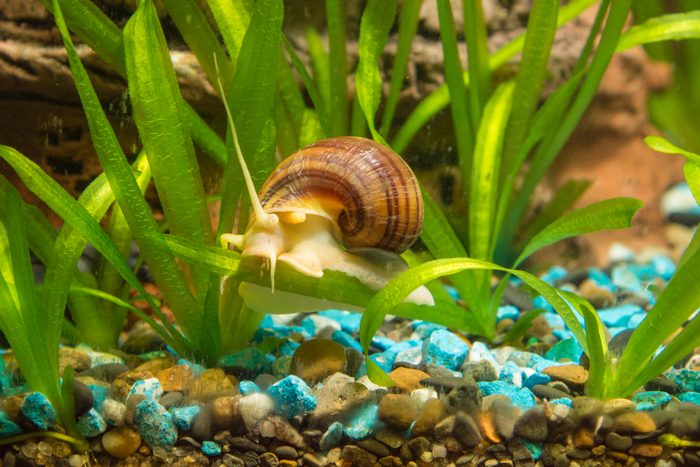How To Get Rid of Snails In an Aquarium
Updated: Jun. 12, 2023

Wondering where all those unwanted snails in your aquarium came from? Learn how they probably got there, and how to send them packing.
Are you suddenly spotting snails creeping up the side of your aquarium wall and you can’t figure out how they got there?
A couple of gatecrashing gastropods in your tank isn’t a disaster. Snails aerate substrates, break down fish waste and clean the tank by gobbling up algae and uneaten fish food.
However, if you’re not careful, these slimy suckers can quickly overpopulate your aquarium. Too many can be a sign your tank needs some maintenance.
Professional aquarist Troy Yarbrough says snails are a particular problem in aquariums with live plants, gobbling up their favorite vegetative food sources. “They can also clog filter intakes and detract from the overall beauty of the system,” he says.
Learn how to get rid of snails in an aquarium and prevent more from taking their place with these expert-approved tips.
On This Page
How Do Snails Get In an Aquarium?
While some hobbyists deliberately introduce certain snail species, not all are invited.
Yarbrough says unwanted snails are stowaways that usually arrive with new live plants or fish. They even hitchhike on driftwood, gravel and fish feces. They can enter as eggs, babies or full-grown adults.
“Baby snails can be very tiny [the size of a grain of sand] so it’s easy to miss them,” Yarbrough says.
How Do Snails Reproduce?
Even if you only have a single snail stowaway, your tank can still be overrun. That’s because most snails are prolific procreators who fertilize their own eggs. Plus, these fast-growing mollusks can start reproducing at just over a month old, with some species laying dozens of eggs at a time.
How To Get Rid of Snails in an Aquarium
If you have a plague of stubborn snails, it’s often easier to manage the population than eradicate them altogether. Thankfully, there are safe and natural methods you can use. “It may take a while, but you can greatly reduce their numbers with some patience and diligence,” Yarbrough says.
1. Manually remove snails
If you spot snails in your tank, Yarbrough recommends taking out as many as possible. You can do this with a snail-catching device, by net or by hand. Or you can siphon them out when vacuuming your aquarium sand or gravel.
To lure whole families for easy snagging, try attaching a lettuce leaf to the aquarium glass before you go to bed. Snails love lettuce. The following morning, lift out the leaf and any feasting snails.
You probably can’t evict all slimy tenants this way, but it can reduce the population to a more manageable level.
2. Reduce fish feeding
Yarbrough says overfeeding fish is the most common reason for a snail population explosion. Leftover food falling to the bottom of the tank is a snail banquet. And that extra sustenance allows them to produce more offspring.
Feed smaller quantities of high-quality food less frequently to avoid wasteful leftovers. Also, regularly prune plants, clean off algae and remove debris from your substrate so remaining snails lack an abundant food supply. Consider these fish for an aquarium, according to the experts.
3. Add snail-eating tank inhabitants
Try introducing new tank tenants to get rid of snails, as long as they’re compatible with your existing fish.
“Add snail-eating fish such as Yoyo loaches or clown loaches,” Yarbrough says. “If you minimize feedings, the loaches will stay hungry and eat snails more effectively.” Loaches make a meal of eggs as well as adult snails.
4. Introduce snail traps
Elusive snail species that burrow into the substrate and only resurface at night might be hard to spot. Try buying a snail trap and put an enticing snack of lettuce or cucumber inside it in the evening. Then empty the trap the following morning. Rinse and repeat until the trap comes up empty.
What Not To Do To Get Rid of Snails in an Aquarium
While chemical treatments like copper can kill snails, Yarbrough doesn’t recommend them. These quick-fix solutions might appeal to you, but they can harm other aquatic life. Choose safer, natural methods instead.
“The dead snails will pollute the water and put the fish at risk,” Yarbrough says. “You could also bleach the tank and start over, but you have to remove the fish first, and this will kill the beneficial bacteria.”
Bleaching isn’t something Yarbrough endorses, either. Because it’s highly toxic to fish, you risk killing off your tank inhabitants if you don’t rinse everything thoroughly.
How To Prevent Snails in an Aquarium
Spotting eggs and baby snails bumming a ride on new plants or fish can be tricky. Some tactics to reduce the chance of them setting up residence in your tank include:
- Quarantine new plants or fish for several weeks and watch for signs of hatching snail eggs.
- Inspect plant leaves (including their undersides) and any other new inhabitants for signs of snails or their eggs before putting them in the aquarium.
- Run plants under water to wash away hidden hangers-on.
- Yarbrough also suggests dipping plants in potassium permanganate as a preventative. Use around 10 mg per liter of water. Dip the plants in the solution for around 10 minutes. Rinse the plants well after soaking.
- Keep up your regular tank maintenance. That’s generally the best solution.
